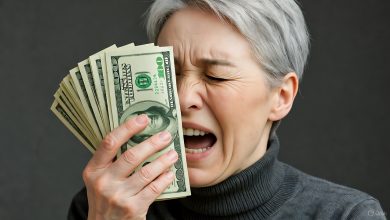The Need For Investing Big Money To Make Life-Changing Money

This type of post only surfaces during a bull market, when greed tug at us the hardest, making satisfaction elusive. Ever since making my first public equity investment in 1996, I’ve been hooked, wrestling with the constant mental tug-of-war over how to be at peace with my investment decisions. Maybe you fight the same battles.
During the spring 2025 stock market meltdown, I deployed most of my rental home sale proceeds into the stock market. I started buying too early—in early March—only to watch stocks keep falling. Still, I kept dollar-cost averaging through mid-April. Eventually, the market rebounded.
Of the proceeds I invested during March and April, about $500,000 went into individual stocks, mostly in tech. Of that, $40,000 went into Meta, a long-time holding in my rollover IRA.
My first new Meta buy was on March 10 at $591.76 a share. When it dropped to $488.50, I felt like an idiot, but defiantly bought more. My last dip-period purchase was at $716.64 before rotating into value names.
As a DIY investor determined to outperform, active management can be very stressful. Unless you truly enjoy the investing process, you are better off sticking with 100% passive index funds or ETFs or hiring a financial professional to manage your portfolio.
The Need To Invest a Lot to Make a Lot
For two months, I felt more stressed than when guessing “C” on all the SAT questions I didn’t know. I was also just as nervous as waiting the 30 seconds for my Series 7 exam results to hopefully break 70%. Back at Goldman, failing would’ve been humiliating.
All that time, stress, and effort to put $40,000 into a volatile tech stock and five months later, I’m up 43%. That’s a solid return. But in dollar terms, it’s only $17,200 before taxes. That doesn’t even cover half the cost of remodeling my parents’ two-bedroom in-law unit in Hawaii.
Yes, $17,200 is better than losing $17,200 in a bear market, but it’s a bull market now so I expect to profit. However, the money doesn’t change my lifestyle as I strive to build more passive income. If I reinvested it in a 4% yielding asset, my annual gross passive income would rise by just $700. A couple of traffic tickets and the passive income is wiped out.

In addition, unlike real estate, the funny money gains in the stock market can evaporate quickly given how rich valuations are.
As an active investor with part of my capital, I also take losses. For example, I’m currently down about $6,000 from dollar-cost averaging into UnitedHealthcare since the $300/share level. What a disappointment as the S&P 500 marches higher.
The Courage to Take Big Risks Is Elusive
Looking back, I should have invested far more in Meta during that window or used options for leverage. But I wasn’t willing to take such a concentrated bet. Government policy was highly uncertain and stocks were richly valued. As growth stocks ride the escalator up, they tend to take the elevator down.
Fear of loss naturally throttles one from making outsized returns. At least it does for me.
That’s the dilemma: to get really rich, you need to take outsized risks. Without them, it’s tough to outperform the crowd who mainly invest in index funds. But most of us are simply too afraid to take outsized risks because we fear loss more than we appreciate gain.
Take the MBA student from a top 25 school. They build connections, analyze companies through case studies, and learn how to build a business. But what do most do instead? They take well-paying jobs in finance, tech, or consulting.
After two years of lost income and $150,000 in tuition, playing it safe makes sense. That’s what I did, returning to Credit Suisse once my MBA was done. It then took another six years for me to finally take the leap of faith in 2012 and focus more on Financial Samurai.
My Biggest Single Investment Slug
In 1Q 2025, with markets so volatile I wasn’t about to put much more than $50,000 into a single stock. Instead, I mostly bought $2,000 – $10,000 tranches of the S&P 500 as the index was declining.
Then I made my largest single investment with the proceeds, a $100,000 allocation to the Innovation Fund. Because it’s diversified across at least 13 private growth companies, I didn’t see it as overly risky. It was more like investing $8,000 in each of the companies in the fund.
In my podcast with Fundrise CEO Ben Miller, I asked about the fund’s concentration risk, given OpenAI, Anthropic, and Databricks make up about 50% of its portfolio. Although I may have sounded concerned, the truth is, I want even more concentration for this bucket of money! They’re hyper-growth AI companies, and $100,000 in that space is a bet I’m comfortable with.

Not Going to Get Rich on $100,000 Either
Sadly, investing $100,000 is probably not going to improve my life either.
In retrospect, I should have also put more into the Innovation Fund, as $100,000 was less than 7% of my home sale proceeds. With Anthropic now valued at $170 billion and OpenAI offering secondaries at $500 billion, a larger position would have yielded more upside.
My target for venture is usually 10–20% of investable capital, which would have meant $150,000–$300,000 in this case. But somehow, I just decided on $100,000, probably because it sounded like a nice round number. I didn’t think things through, especially as the stock market was tanking.
This lack of consistency in investing is why the forced savings aspect of owning a home with a mortgage is such a powerful wealth builder.
Quick Calculation On A Potential $100,000 Return
If the fund delivers a 25% IRR over five years, $100,000 grows to about $305,000—just over 3X my money. Over ten years, it becomes roughly $931,000, or 9.3X. Those are impressive numbers, but at age 53, $305,000 wouldn’t move the needle much. Maybe I’d splurge on a Toyota Tundra in Honolulu, guilt-free, but that’s about it.
At 58, $931,000 could cover a full remodel of my parents’ old house. But after my last gut remodel, I swore I’d never do one again. It’s just too painful and time-consuming.
More likely, I’d put the proceeds toward buying a fully remodeled home in Honolulu. That said, I should already have enough for that once I sell my primary residence in San Francisco and use the tax-free exclusion benefit.
Can the fund actually return 25% a year on average for a decade? That’s a tall order.
I Want To Have A $500,000 Position
If I’m willing to save and invest ~$500,000 for each kid’s 529 plan, then I should be just as willing to put $500,000 into private AI companies that might make their college education obsolete.
Now, let’s dream for a moment: if I had invested $500,000 and somehow earned a 40% IRR for 10 years, that would grow to around $14.4 million. That’s truly life-changing money off a single bet.
With an extra $14.4 million, I could fly private, rent $100,000-a-month luxury vacation homes, buy a $200,000 family car, and donate a generous $5 million to “help” my kids get into college. How obscene! But that’s what the richest people do all the time.
The problem? Sustaining a 40% IRR is nearly impossible without catching lightning in a bottle with an early-stage startup—or three. The other issue is that investing 33% of my stable home-sale proceeds into venture capital is aggressive, especially when my target allocation is 20%.
For context, the S&P 500’s historical average return since 1926 is about 10%. Still… it’s nice to dream big.
The Only Real Ways to Get Truly Rich Are:
- Start rich and invest heavily to get richer.
- Invest a large sum in an asset that massively outperforms over the long term.
- Build a successful business where you own a significant chunk of equity.
- Get lucky—by joining the right startup, climbing to the top of the ranks, or knowing the right people to help you get in on a great investment
Clearly, not everyone is born rich, has the courage to build a business, or can invest a large sum into a risky venture. And while luck is uncontrollable, you can take steps to improve your odds, like moving to San Francisco during the AI boom.
So what’s the solution? Consistently swing for the fences with a percentage of your capital.
Carve Out a Portion of Your Capital for High-Risk Bets
The best way I’ve found to overcome the fear of high-risk investing is to ring-fence a small portion of capital and consistently put it into aggressive opportunities. I recommend a 10% to 20% allocation.
Take 10% of your investable cash flow, savings, or financial windfalls and put it toward the highest-risk, highest-reward assets you can stomach. If you lose it all, you’ve only lost 10%. But hit a 10-bagger or greater, and it moves the needle on your overall wealth.
As wealth grows, the instinct is to play defense and protect capital. After all, you don’t want to be forced back into the “salt mines” during the next downturn. But resist going too conservative with everything. Keep that 10% – 20% high-risk bucket alive.
Some sample allocations:
- Age 25, $50,000 investable: $5,000 speculative, $45,000 S&P 500
- Age 30, $200,000 investable: $20,000 speculative, $170,000 S&P 500, $10,000 liquid
- Age 35, $500,000 investable: $50,000 speculative, $250,000 S&P 500, $200,000 real estate, $50,000 liquid
- Age 40–60, $1,000,000 investable: $100,000 speculative, $600,000 S&P 500, $250,000 real estate, $50,000 liquid
Or take a percentage of monthly savings. If you save $5,000 a month, put $500 into speculative bets. Over a year, that’s $6,000. As your income and savings grow, so do the bets.
Practice Letting Go of High-Risk Capital
I already treat my kids’ custodial accounts, Roth IRAs, and 529 plans as no longer mine. That mindset makes it easier to stomach downturns and stay the course. In fact, whenever the stock market drops, I get defiant and aggressively invest in my children’s accounts to help them build wealth.
Apply the same strategy to high-risk investments. Once you commit the money, mentally write it off. It’s easier to do when it’s just 10–20% of your capital and you still have the other 80–90% safe. This detachment makes it easier to make bets, hold them longer, and avoid panic selling.
Stay Consistent With Your Aggressive Investing
The formula for building serious wealth is simple but uncomfortable: invest large sums in concentrated positions, earn high returns, and repeat consistently. The real challenge is maintaining the discipline to keep funding that high-risk bucket year after year.
Automate contributions to your brokerage account, open-ended venture funds, and other investments. Over time, that steady drip adds up.
Readers, are you suffering from greed and dissatisfaction in this bull market? How do you ensure you’re consistently investing and hunting for potential multi-bagger opportunities? And if you’re not chasing life-changing money, how did you reach the point of being truly content with what you have? What guardrails do you use to avoid overextending in risky bets?
Subscribe To Financial Samurai
Pick up a copy of my USA TODAY national bestseller, Millionaire Milestones: Simple Steps to Seven Figures. I’ve distilled over 30 years of financial experience to help you build more wealth than 94% of the population—and break free sooner.
Listen and subscribe to The Financial Samurai podcast on Apple or Spotify. I interview experts in their respective fields and discuss some of the most interesting topics on this site. Your shares, ratings, and reviews are appreciated.
To expedite your journey to financial freedom, join over 60,000 others and subscribe to the free Financial Samurai newsletter. Financial Samurai is among the largest independently-owned personal finance websites, established in 2009. Everything is written based on firsthand experience and expertise.
Source: The Need For Investing Big Money To Make Life-Changing Money



